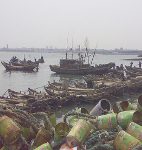News came from my hometown earlier this year: the local government had decided to spend 50,000 yuan (about US$7,300) sinking new wells to combat shortages of water for irrigation. The site used to be wetland; back in the 1960s, people used to grow rice there. But when the drilling team started work in April they sank a 200-metre-deep shaft and found no sign of water. In May they were forced to give up.
How was it possible that no water could be found under a former wetland? The locals were astonished. The story started back in the 1980s, when land reforms encouraged farmers to raise their own crops, causing a shortage of land. Wetlands were reclaimed and trenches dug to drain water away; springs were blocked with sand and covered with soil. The wetlands dried out to make way for more arable land. Surrounding villages followed suit; ponds and waterways were covered over and riverside vegetation cut back. Even centuries-old graveyards were used to raise crops. In rural areas, anywhere that once held water was flattened; in and around the towns, they were tarred or concreted over. Farmland increased, but the wetlands were lost and the weather got drier. Now you cannot find a drop of groundwater.
The national situation is even more worrying. The northern province of Hebei lost 90% of its wetlands in the last 50 years; 80% of what is left is polluted. In Shaanxi province the 30 counties in the Guanzhong area have seen up to 10,000 ponds disappear. Poyang Lake, China’s largest freshwater lake, now shrinks to as small as 50 square kilometers, down from 4,000 at its peak. The loss of wetlands has meant aridity spreading from the north to the country’s fertile south. In 2007, tens of millions of people living around Poyang Lake suffered drinking water shortages. Wetlands in arid and semi-arid regions are not faring any better. Alashan, in Inner Mongolia, is seeing wetlands dry up due to water abstraction from the Hei River upstream. Water flowing into this traditionally green area has dropped from 900 million cubic metres to 200 million, leading to the disappearance of hundreds of lakes and ponds. The creation of new farmland around the upper reaches of the Tarim River, in Xinjiang autonomous region, has lead to a 350 kilometre-stretch of the river drying up, with deserts appearing where lakes once were.
Many are quick to blame the loss of wetlands on climate change. Global factors and a lack of precipitation do, to a certain extent, present a threat to wetlands, particularly in areas which are already arid or semi-arid. However, we cannot ignore human activity in rural areas. In most areas the loss of wetlands is not a natural disaster, but a manmade problem.
First, the reclamation of land from lakes, rivers and the sea has directly replaced wetlands with dry land. Land shortages mean that in rural areas any type of wetland – ponds, marshes, the banks of lakes – have been targets for appropriation. During the Great Leap Forward in 1958, a large number of farmers in Hunan province were moved into the Dongting Lake region to reclaim the land, with dykes used to push back the waters of lakes, shrinking it to a fraction of its former size. Hubei, known as the province of a thousand lakes, has gradually transformed its lakes into farmland. What remains is inadequate to mitigate the effects of flooding and drought. The area affected by flooding and drought consequently grew from 460,000 hectares in the 1950s to 1.7 million hectares in the ‘80s. Land shortages are even more severe in coastal areas; the enthusiasm for creating new land remains in Shanghai, Xiamen and other cities. The city of Xiancheng, in Jiangsu province, used to have 582 kilometres of coastal wetlands; now it has only a 50-kilometre “core area” as a habitat for the red-crowned crane and other wildlife. Areas that were once wide expanses of coastal wetlands have been replaced with factories, paper mills, farms and salt pans. Some polluting industries that are no longer welcome in southern China, including chemical plants, printing, dyeing and paper-making factories, have relocated here and represent a potentially fatal threat to the local environment.
Second, reservoirs are cutting off rivers, which means wetlands downstream are shrinking or disappearing entirely. China has more reservoirs than any other nation, with almost 86,000 at the end of 2006. Once a reservoir has been built the downstream areas will only receive water that is not wanted further upstream. The wetlands, which rely on this water, are then at risk. The threat is particular grave to wetlands in arid and semi-arid regions. Ten reservoirs have been built on the 8 tributaries of the Heyang River, in Gansu province, leaving downstream Minqin county severely short of water. It may even meet the same fate as Lop Nur and dry up completely.
Third, the construction of large dams is exacerbating the disappearance of wetlands. There are 22,000 large dams in China; 45% of the world’s total and more than in any other country. The debate continues over the effect of these dams on the environment, but nobody denies that the disruption of water flow causes the loss of wetlands. When the Xiaolangdi reservoir, in Henan province, went into operation on the Yellow River, water levels fell downstream and wetland areas decreased, clearly seen in both shallows and wetlands upstream from Kaifeng. Remote sensing data puts the area of wetlands in the lower reaches of the Yellow River at 724.3 square kilometres in 1997, decreasing to 651.6 square kilometers by 2003. The Three Gorges dam also caused river water levels to drop and drew water out of lakes. In summer 2006 some areas on the upper reaches of the Yangtze River saw the worst droughts since 1949.
Over-extraction of groundwater also causes the loss of wetlands. Aridity, upstream reservoirs and pollution meant that surface water proved inadequate for needs of the public, so they turned to the groundwater hundreds or thousands of metres under their feet. Over-extraction of groundwater in the Hai River basin affects an area of 90,000 square kilometers: 70% of the total area of the plains. At one time, 40% of Tianjin’s land area was wetland, now this has decreased to 7%. Lake Baiyangdian, known as the “pearl of the north”, has dried up on seven occasions since the 1960s, once for five years. Extracting groundwater also causes subsidence, with ground levels dropping by up to three metres in parts of Tianjin. One area of eight square kilometres now lies below sea level.
Pollution is also destroying China’s wetlands. Wetlands can clean up a certain amount of pollution, but there are limits beyond which they are at risk of destruction. All of China’s seven major river systems – the Liao River, Hai River, Huai River, Yellow River, Songhua River, Pearl River and Yangtze River – are severely polluted. The Xiaoqing River in Shandong was once famous for the clarity of its waters, but they now run closer to black. There are 110 waste-water outlets flowing into this river in Jinan city alone, with eight large factories pumping out industrial effluent. Avoiding responsibility for its own pollution, one well known paper manufacturer 50 kilometres away is unloading its waste into the river.
Wetlands are sometimes called the kidneys of the world. Losing them means losing their ability to regulate the climate, absorb floodwaters and clean up pollution; it may worsen droughts and floods and mean the loss of natural habitats for wildlife. We should waste no time in saving China’s wetlands.
Jiang Gaoming is a professor and Ph.D. tutor at the Chinese Academy of Sciences’ Institute of Botany. He is also vice secretary-general of the UNESCO China-MAB (Man and the Biosphere) Committee and a member of the UNESCO MAB Urban Group. He is known for his concepts of “urban vegetation” and allowing damaged ecosystems to recover naturally.
Homepage photo by mke1963



